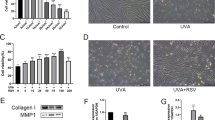Abstract
The anabolic steroid stanozolol stimulates the production of prostaglandin E2 (PGE2) and the matrix metalloproteinases collagenase and stromelysin in human skin fibroblasts but not in rheumatoid synovial fibroblasts. The basis for these differential responses was investigated at the levels of DNA synthesis and steroid receptor binding. Stanozolol inhibited fibroblast growth factor (FGF)-stimulated DNA synthesis in both the skin and synovial fibroblasts, showing that both cell types were capable of responding to the compound. Competitive binding assays indicated that stanozolol bound specifically to both the skin and synovial fibroblasts. Binding of stanozolol to both cell types could be partially displaced by progesterone, indicating that stanozolol binds to the progesterone receptor. Immunocytochemical studies confirmed the presence of progesterone receptors on skin and synovial fibroblasts. However, progesterone failed to elicit any response with respect to collagenase production in either cell type. Nortestosterone, dexamethasone and 17β-oestradiol had no effect on binding of stanozolol to either cell type.
These results indicate that the inhibition of DNA synthesis by stanozolol is elicited through the progesterone receptor. The effects of stanozolol on collagenase and PGE2 production are mediated by a different receptor, present on skin but not synovial fibroblasts, and as yet unidentified.
Similar content being viewed by others
References
J. J. F. Belch, B. McArdle, R. Madhok, K. McLaughlin, H. A. Cappell, C. D. Forbes and A. D. Sturrock,Decreased plasma fibrinolysis in patients with rheumatoid arthritis. Ann. Rheum. Dis.43, 774–779 (1984).
P. E. M. Jarrett, M. Morland and N. L. Browse,Treatment of Raynaud's phenomenon by fibrinolytic enhancement. Br. Med. J.2, 523–525 (1978).
K. Burnand, G. Clemenson, M. Morland, P. E. M. Jarrett and N. L. Browse,Venous lipodermatosclerosis: Treatment by fibrinolytic enhancement and elastic compression. Br. Med. J.280, 7–11 (1980).
J. F. Davidson, M. Lockhead, G. A. McDonald and G. P. McNicol,Fibrinolytic enhancement by stanozolol: A double blind trial. Br. J. Haem.22, 543–559 (1972).
C. Kluft, F. E. Preston, R. G. Malia, R. M. Bertina, G. Wijngaards, M. Greaves, J. H. Verheijen and G. Dooijewaard,Stanozolol-induced changes in fibrinolysis and coagulation in healthy adults. Thromb. Haemost.51(2), 157–164 (1984).
J. J. F. Belch, R. Madhok, B. McArdle, K. McLaughlin, C. Kluft, C. D. Forbes and R. D. Sturrock,The effect of increasing fibrinolysis in patients with rheumatoid arthritis: a double blind study of stanozolol. Quart. J. Med.225, 19–27 (1986).
A. J. Ellis, J. K. Wright, T. E. Cawston and B. L. Hazleman,The differential responses of human skin and synovial fibroblasts to stanozolol in vitro: Production of prostaglandin E 2 and matrix metalloproteinases. Agents and Actions35, 232–237 (1992).
R. L. Barbieri, H. Lee and K. J. Ryan,Danazol binding to rat androgen, glucocorticoid, progesterone and estrogen receptors: Correlation with biologic activity. Fertility and Sterility31, 182–186 (1979).
A. J. M. Audebert,Overview of the mechanism of action of danazol. InRecent Advances in the Management of Endometriosis (Eds. J. A. Rock and K. W. Schweppe), Parthenon, 1988.
J. K. Wright, P. Hughes and N. R. Rowell,Lymphocyte cytotoxicity in systemic sclerosis: no increase on short-term culture with established human cell lines. Ann. Rheum. Dis.41, 414 (1982).
D. Gospodarowicz,Biological activity in vivo and in vitro of pituitary and brain fibroblast growth factor. InMediators in Cell Growth and Differentiation (eds. R. J. Ford and A. L. Maizel), pp. 109–134, Raven Press, New York 1985.
R. G. Ham,Growth of normal human cells in defined media. InHormonally Defined Media (Eds. G. Fischer and R. J. Wieser) pp. 16–30, Springer, Berlin 1983.
E. Sher, J. A. Eisman, J. M. Moseley and T. J. Martin,Whole cell uptake and nuclear localisation of 1,25-dihydroxycholecalciferol by breast cancer cells (T47D) in culture. Biochem J.200, 315–320 (1981).
T. E. Cawston and A. J. Barrett,A rapid and reproducible assay for collagenase using 1-14 C acetylated collagen. Anal. Biochem.99, 340–345 (1979).
C. M. Taylor, B. Blanchard and D. T. Zava,A simple method to determine whole cell uptake of radiolabelled oestrogen and progesterone and their subcellular localisation in breast cancer cell lines in monolayer culture. J. Steroid Biochem.20, 1083–1088 (1984).
G. Jenkin, C. I. Cookson and G. D. Thorburn,The interaction of human endometrial and myometrial steroid receptors with danazol. Clin. Endocrinol.19, 377–388 (1983).
D. D. Wood, E. J. Ihrie, C. A. Dinarello and P. L. Cohen,Isolation of an interleukin-1-like factor from human joint effusions. Arth. Rheum.26(8), 975–983 (1983).
D. M. Butler, D. S. Piccoli, P. H. Hart and J. A. Hamilton,Stimulation of human synovial fibroblast DNA synthesis by recombinant human cytokines. J. Rheumatol.15, 1463–1470 (1988).
T. Leizer, B. J. Clarris, P. E. Ash, J. van Damme, J. Saklatvala and J. A. Hamilton,Interleukin-1α and interleukin-1β stimulate the plasminogen activator activity and prostaglandin E 2 levels of human synovial cells. Arth. Rheum.30(5), 562–566 (1987).
T. C. Spelsberg, M. L. Graham, N. J. Berg, T. Umehara, E. Riehl, C. B. Coularn and J. N. Ingle,A nuclear binding assay to assess the biological activity of steriod receptors in isolated animal and human tissues. Endocrinology121, 631–644 (1987).
A. Guiochon-Mantel, H. Loosfelt, T. Ragot, A. Bailly, M. Atger, M. Misrahi, M. Perricaudet and E. Milgrom,Receptors bound to antiprogestin form abortive complexes with hormone responsive elements. Nature336, 695–698 (1988).
R. L. Barbieri and K. J. Ryan,Danazol: Endocrine pharmacology and therapeutic applications. Am. J. Obstet. Gynec.141,
Author information
Authors and Affiliations
Rights and permissions
About this article
Cite this article
Ellis, A.J., Cawston, T.E. & Mackie, E.J. The differential effects of stanozolol on human skin and synovial fibroblastsin vitro: DNA synthesis and receptor binding. Agents and Actions 41, 37–43 (1994). https://doi.org/10.1007/BF01986391
Received:
Accepted:
Issue Date:
DOI: https://doi.org/10.1007/BF01986391




